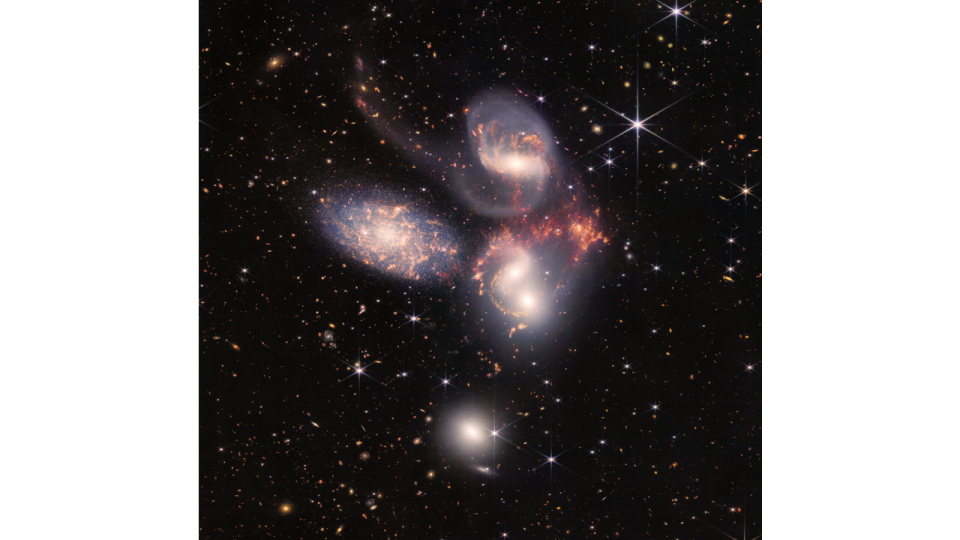New James Webb telescope pictures zoom in on various types of galaxies
The James Webb Space Telescope’s first picture released to the public showed off thousands of galaxies. At first glance, the pinpoints of light shining in the blackness of space look like little stars.
But when you zoom in, you can see that they are galaxies of stars in various sizes, colors, with both spirals and irregular shapes. And this is just one tiny section of the universe. Astronomers speculate there are about two trillion galaxies in the universe.
What is a galaxy?
A galaxy is a humongous collection of stars, gas and dust that circle around a common center of mass. Galaxies can consist of millions to trillions of stars.
The galaxy we live in is called the Milky Way, and astronomers estimate it has between 200-400 billion stars. The spiral arms of the Milky Way stretch about 100,000 light-years, and the sun (and our solar system) reside about two-thirds of the way out from the center of the galaxy. The Milky Way is so large that it takes the solar system about 230 million years to circle it.
Galaxy types: 101
There are three main types of galaxies: elliptical, spiral and irregular. The largest galaxies are called elliptical because they look like big globes of light emitted from a multitude of stars. The most famous elliptical galaxy is M87, which has up to 2.4 trillion stars. Astronomers recently used a combination of special telescopes to image the center of M87 and the supermassive black hole that dwells there.
Spiral galaxies look like flat pinwheels. They have a bright bulge of light near their center, which is where the majority of the galaxy's stars reside. The Andromeda Galaxy is the closest spiral galaxy to the Milky Way but is still about 2.5 million light years away. It is the only spiral galaxy you can see with the naked eye.
Irregular galaxies do not have a clear shape or structure. They look like blobs of stars and are usually smaller than the other types of galaxies. From the Earth’s Southern Hemisphere, you can see two irregular galaxies in the sky without a telescope. These are called the Large Magellanic Cloud and the Small Magellanic Cloud.
James Webb Space Telescope pics
The Whirlpool Galaxy lies about 27 million light-years away and contains hundreds of billions of stars. The stars are spread out into a pinwheel shape clustered around a black hole at its core. In the latest JWST image, you can see the more distant stars through the black bubble-like windows, giving the image a 3D effect.
Vast distances most often separate galaxies from each other. But occasionally, two or more galaxies interact and even collide.

JWST captured a galaxy group called Stephan’s Quintet with unprecedented clarity and detail. Here, four galaxies are close enough to each other that they gravitationally mingle. The fifth galaxy in the quintet is much closer to Earth and only looks like it is part of the group.
To really absorb the different shapes and structures of galaxies, JWST just released a mosaic of 19 different galaxies. They show the different patterns of star formation and evolution as well as evidence of supermassive black holes at their cores.
The farthest galaxy imaged by JWST is named JADES-GS-z13-0. It is a tiny, blurry blob of light barely detectable because it lies about 13.4 billion light-years from Earth. This also makes it one of the earliest galaxies to have formed after the Big Bang.
Dean Regas is an astronomer, host of the Looking Up podcast, and author of six books including '100 Things to See in the Night Sky.' He can be reached at: www.astrodean.com.
The Spring Sky: Online Astronomy Class
What: Explore the night sky from the comforts of your home. Join astronomer and host of the Looking Up podcast, Dean Regas, for a fast fun spin around the stars, constellations, and planets of the season to come.
When: Tuesday, March 5, at 7 p.m.
Tickets: $10 per household.
Information: Watch the class live or view the recording later at your convenience. Register at: astrodean.com/shop.
Take this quiz to test your knowledge of Cincinnati history.
This article originally appeared on Cincinnati Enquirer: New James Webb Space Telescope pics show various types of galaxies

